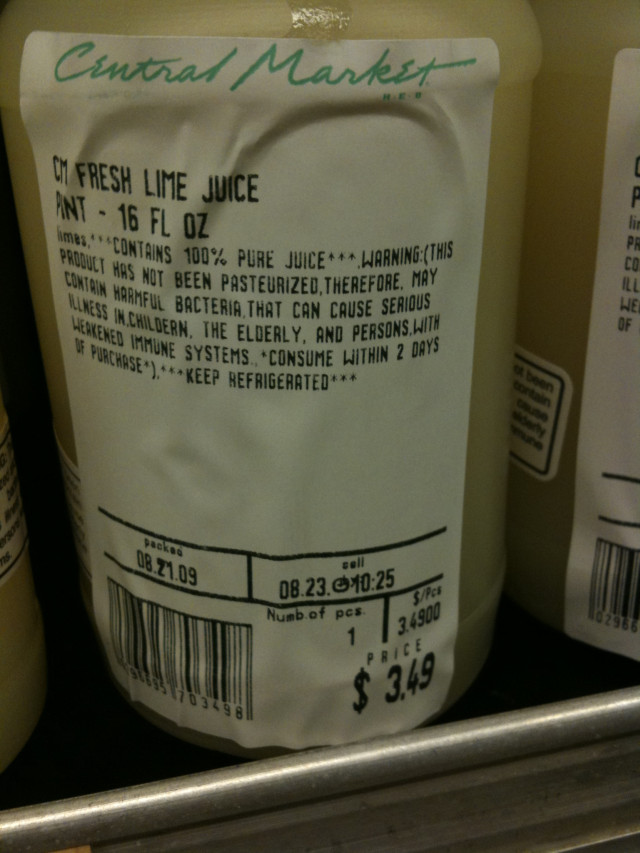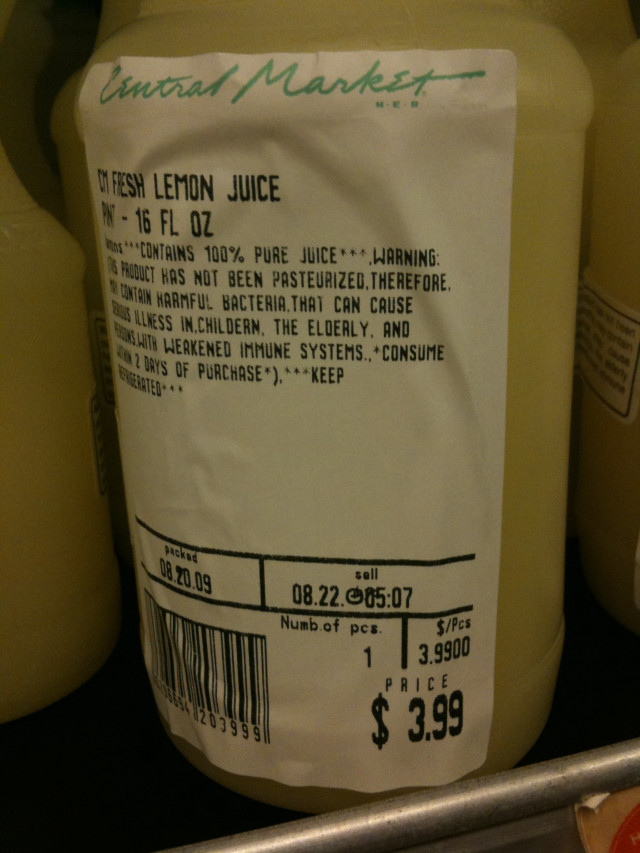After watching Alton Brown’s Live And Let Diet episode, I had to modify my grilled tuna melt sandwich. This time I used H.E.B.’s Jalapeno Cheese bread, Boar’s Head Monterey Pepper Jack Cheese, King Oscar Finest Brisling Sardines, and Hass Avocados. It turned out to be quite decadent. Definitely comfort food!
Category Archives: Cooking
Umami Black Beans
Lately, I have been on a black bean mission with my cooking experiments. I have tried a more vegetarian version by substituting gelatin or pectin as the thickening agent instead of beef bones (I never got around to trying Lieber’s Unflavored Jel). But it just doesn’t work as well. So, for this attempt, I went back to my old standby oxtails. However, I did try adding smoked paprika. This did not make the beans better in my opinion. You couldn’t really notice the paprika note and I did not like the bright red tint either.
Back to umami though which is the real point of this recipe. The first interesting blog mention of umami that I came across was umami salt. However, I didn’t act immediately upon it. It percolated in the far recesses of my mind for a while.
I started to research lists of foods high in umami. One version lists bonito and kombu among others. This made me think of the fundamental Japanese soup stock, dashi. Since it is a mild broth, I thought it would be perfect as a base for cooking the black beans. The next easy umami thing to add is shiitake mushrooms that are ground into a fine powder.
When one of my cooking blogs that I read posted about extracting the best flavor of kombu here, the tipping point was finally reached! I researched the kombu highest in glutamic acid. However, you need good luck in finding specialized types in Austin. I did find Hidaka Kombu in Asahi Imports. Also, here is an interesting article on kombu.
I made another discovery about cooking beans as well! Soaking and cooking them in hard water will not soften them fully. Here is an article which talks about the problem. I suggest using distilled water to both soak and cook in.
So, the recipe follows:
Dissolve 3 heaping tablespoons of Kosher salt in 7 cups of distilled water. Sort one pound of black beans for any rocks, broken or discolored beans. Soak the beans overnight.
Cook 14 grams of Hidaka Kombu and 14 grams of dried bonito shavings (Katsuobushi) in 6 cups of distilled water simmering at 65 degrees Celsius (149 degrees Fahrenheit) for one hour. Strain.
Rinse hydrated beans well and put into the dashi stock. Grind 15 grams of shiitake mushrooms into a fine powder with a clean coffee grinder. Add two bay leaves, 5 cloves of minced garlic, 1 tablespoon of onion powder, tablespoon ground black peppercorns, 1/2 teaspoon of Wright’s Liquid Hickory Smoke, and 2 pounds of beef oxtails. Cook, covered, in an oven set to 275 degrees for 1:30:00. Remove oxtails and bay leaves. Add smoked salt to taste.
Quintessential Fall Dinner
Smoked Ham, stuffing, sweet potatoes, and cranberry sauce are all Fall items to me. And I can’t really name Spring, Summer, or Winter items either.
Cheap and varied vegetarian lunches
Lately, I have been using Indian side dishes, packed in foil pouches, and stored in the pantry to compliment mixed frozen vegetables. Each of those boxes cost 2 dollars for 2 servings. And the Indian grocery store/restaurant that I go to, Teji’s, has a selection of more than twenty of them.
At H.E.B., I buy bags of four frozen vegetables for around a dollar a piece: green peas, sweet corn, crinkle cut carrots, and broccoli & cauliflower. I can get 7 or 8 servings from them.
$12.50 for 8 meals is pretty darn cheap. There are 143 calories from the vegetables and an average of 145 calories from the side dish (a low of 80 to a high of 208).
Bacon, guacamole, and tomato sandwich
Sigh. I forgot the lettuce at the store. But I wasn’t going to let that stop me from using the bacon in a sandwich.
I didn’t spend much time futzing around with the picture. But, looking at it afterwards, I know that I could have done better. The top of the bacon could have used a low angle, oblique flash to bring out the 3D texture.
Two swings, two misses. But at least the sandwich still tasted good…
Black Beans redux
With a new method of cooking beans, I needed to raise them up a level. One of the things that I like about Rudy’s beans is the extra flavor they add to a bowl of plain, frozen vegetables. So I decided to try adding some meat to the picture. And I went with an unknown meat as well: two and a half pounds of ox tails. I knew that I need to braise the beef to turn the tough connective tissue, collagen, into gelatin. Since I was already cooking the beans in a low oven, I had the perfect environment to braise.
The first step was to brown the meat in a dutch oven. I then poured water half way up the meat, covered the pot, and put it into a 250 degree oven for two hours and forty-five minutes. After that, I added the rinsed beans and placed them back into the oven for an hour and a half. Then removed them and placed them in the refrigerator to cool down.
The first thing that I noticed after removing them from the refrigerator, was that there no condensation on the top of the container. I first that that the layer of fat might have been responsible. But when I scraped off the solidified fat, I noticed that the rest of the liquid was jelly-like. Apparently, there was no free water to condense.
For the next time, I am going to try a vegetarian version. I would add apples for the pectin, a little bit of molasses, liquid smoke, smoked paprika, and chipotle.
Black Beans
Lately, I have been experiment cooking basic black beans. I was intrigued with a recipe from America’s Test Kitchen. It involved performing two things that I haven’t tried before (at least with beans). These were brining and cooking in the oven. And the recipe is as follows:
Remove any stones or ugly beans from a one pound bag of black beans. Soak them overnight (unrefrigerated) in four quarts of water with three tablespoons of salt added (dissolved of course).
Discard the water and rinse the beans thoroughly a couple of times to remove the salt. Cooking beans in salted water will toughen the skins. However, beans soaked in salted water will help create a creamy texture.
Put the beans in a pan and cover them with water. Add sliced garlic, a couple of bay leaves, oregano, onion powder, and some chopped pancetta. Bring the water up to a simmer. And then place the covered pan into an oven set to 250 degrees Fahrenheit. Cook the beans for an hour.
The beans came out great! The next time I am going to try cooking some meat in there. The temperature is perfect for converting collagen into gelatin. I think a pound of Ox tails would work well.
iced tea
One of the first drinks that I started to make was iced tea. The amount of sugar in Coke/Pepsi was getting to be too much for me. So I started to look for an alternative. Iced tea sweetened with some lemon juice and agave nectar did the trick. I like the convenience of Celestial Seasonings tea bags. And I found four flavors that I liked at HEB (Mandarin Orange Spice, Black Cherry Berry, Raspberry Zinger, and Wild Berry Zinger). Unfortunately, once I find something that I like, stores stop carrying them. Luckily for me, Amazon does carry those flavors. So I buy a case of each and it lasts me for about a year.
It is not that hard to make. I fill by teapot full of water and bring it to a boil. I then take eight bags of tea and steep them in the water for 6 minutes (actually, you can forget about them and let them steep longer than that without any harm). While the water is coming up to a boil and/or steeping in the tea, I squeeze the juice of three lemons into a clean 64 ounce plastic container. I then pour in 100 grams of organic raw blue agave nectar. I fill the bottle about half way with cold water and wait for the tea to finish steeping. When it is done, I port the tea in and fill it up to the top with cold water and place it in the refrigerator for when I need it (and for it to chill back down).
A hundred grams of agave sweetener in a 64 ounce bottle works out to be 36 calories per 8 ounce serving (10 grams of carbohydrates).
Yogi tea
I experimented and tried making some tea that Yoga Yoga serves after class. They helpfully provide the recipe here. I have copied it down here just in case it might disappear.
- 2 quarts water
- 15 whole cloves
- 20 black peppercorns
- 3 sticks of cinnamon
- 20 whole cardamon pods (split the pods first)
- 8 ginger slices (1/4″ thick, no need to peel)
- 1/2 teaspoon black tea leaves (we use decaf)
Bring 2 quarts of water to a boil in a 3-4 quart pot. Add cloves and boil for one minute. Next, add cardamon, peppercorns, cinnamon, and fresh ginger root. Cover and boil for at least 30 minutes. For best flavor, cover and simmer for 2 to 3 hours! When ready, remove from heat, add black tea and let cool. Strain tea. When ready to drink, add soy or dairy milk and sweeten to taste with agave nectar.
Thumbs up! It is pretty spicy! And you have to give it bonus points for using peppercorns.
Freezing homemade lemonaid
When I made lemon/lime aid this time, I made enough for two servings. I froze half of juice for a later serving. Which worked out well.
I bought 12 lemons for 3.99 and 30 limes for 5.00. This turned into 56 ounces of juice. Which was perfect for two 28 ounce servings.
To make the lemon/lime aid, combine 28 ounces of juice with 56 ounces of water and 350 grams of agave nectar. This just fits within my plastic serving container.


I checked on the prices for fresh squeezed juice in Central Market. They sell 16 ounces of lime juice for 3.49 and 16 ounces of lemon juice for 3.99. So it it certainly cheaper to do it myself. Plus, I don’t have to drive all the way down to Central Market. Too bad they don’t sell frozen juice concentrate without sugar in the grocery store.
